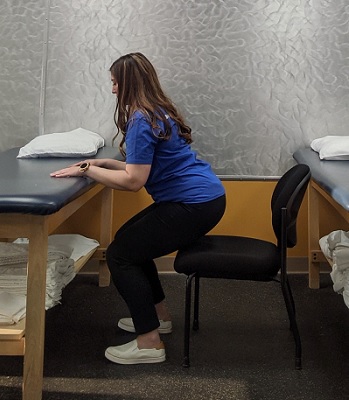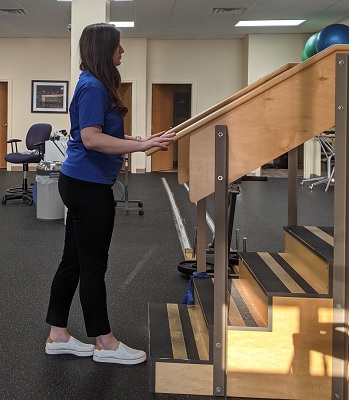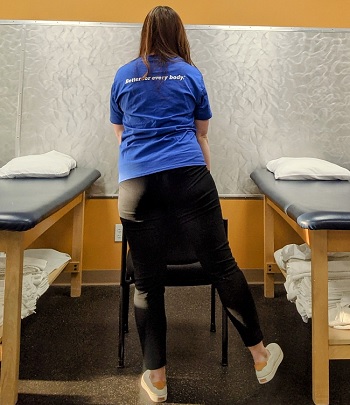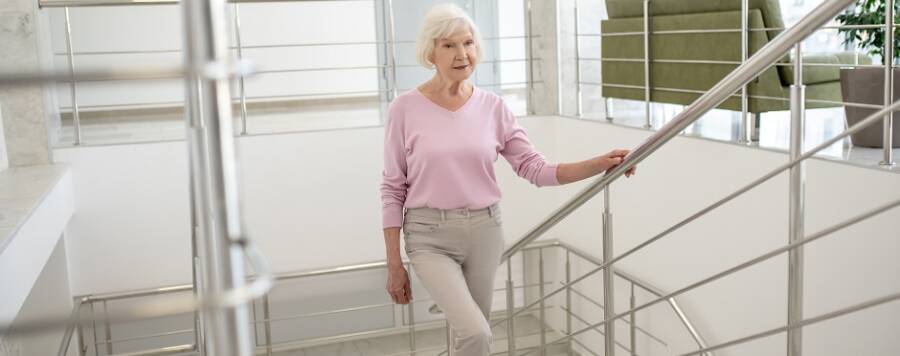Decrease Fall Risk
As we age, falls become more common and can lead to more severe injuries. Each year, 25% of adults 65 and older experience a fall.2 Falls can be associated with weakness, balance issues, medication use, or obstacles within the home and community. While we cannot prevent all falls completely, we can try to decrease the risk of a fall, and one way to decrease your risk is to do strength and balance training.
Help with Arthritis Pain
Muscle weakness is common in people with osteoarthritis (OA) and can be associated with functional limitations such as difficulty walking or climbing stairs.1 Strength training has been shown to help with pain from osteoarthritis.1 For those with OA, adherence to exercise programs may be difficult due to pain in the joints. However, research shows that pain levels can be reduced in those with OA by performing a progressive strengthening program. It’s important to note that dosage of strength training should be individualized.
Improve Mood
Exercise has many benefits including decreased risk of depression, improved health status, and improved reports of happiness. Concurrently, a sedentary lifestyle has been associated with many poor health outcomes.4 When we exercise, the body releases chemicals that boost your sense of well-being and suppress hormones that cause stress and anxiety. Among the chemicals released are endorphins, serotonin, and dopamine neurotransmitters which are related to pain and depression emotions.4
Health Benefits
Studies have shown that 20-30 minutes of strength training 2-3 times per week can have positive effects on risk factors for cancer, diabetes, osteoporosis, and cardiovascular diseases.3 In terms of function, regular strength training can increase distance walked, ability to rise from a chair, and subjective reports of higher mobility.3
5 Strengthening Exercises to Try
1. Sit to Stand
- Start by sitting on a sturdy chair that will not slide or roll. You should be able to sit comfortably with feet flat on the ground. You can also have a counter top in front of you in case you need it for support.
- Begin by scooting forward in the chair so your buttocks is toward the front of the seat.
- Lean your chest forward to shift your weight forward and squeeze your glute muscles as you rise to a standing position.
- Slowly sit back down, try not to “plop” down! Repeat 10 times. The goal is to not use your hands but if you need to push up from the chair seat or arms at first go ahead.

2. Tandem Balance
- Stand at the kitchen counter or in front of a sturdy object like a table.
- Stand with your arms relaxed and place one foot in front of the other so the heel of the foot in front is past the toes of the foot behind. Hands may be used for support if needed to avoid loss of balance.
- Try to hold this position for 30-60 seconds then switch the feet to challenge the other side.

3. Wall Push Up
- Using a wall or counter place hands slightly wider than shoulders.
- Move feet back until you are at a comfortable angle, bend your elbows and slowly lower your chest toward the wall while keeping your body straight by engaging your abs and buttocks.
- Try to perform 10-15 repetitions and 1-2 sets to begin. To make this more difficult, reduce the incline from the wall to a counter or a bench.

4. Side Leg Lift
- Stand at a counter top for support and balance.
- Keep your hips facing the counter and your body upright.
- Kick one leg to the side while keeping the toes facing the counter and do not lean your body.
- Perform 10-15 repetitions and 1-2 sets per leg. This exercise will work both the standing leg and the moving leg in the hips.

5. Step Ups
- Perform on the bottom step of a staircase with rails or on an exercise step.
- Begin by placing your right leg up on the step and follow with the left leg, then return the left leg to the floor; keep the right foot on the step the entire time.
- Do 10 reps on the right foot then switch to the left foot. This exercise can be made easier or more difficult by changing the step height, a shorter step is easier and a taller step is harder.

Choose Athletico
Strengthening for the older adult has many benefits. Exercise programs should be selected that best fit into your lifestyle as you will be more likely to stick with a program you enjoy. As with any program, consult your doctor prior to starting or reach out to your nearest Athletico to discuss strengthening with a physical therapist. Get started by scheduling a Free Assessment today. Free Assessments are available in-clinic and virtually through our Telehealth platform.
The Athletico blog is an educational resource written by Athletico employees. Athletico bloggers are licensed professionals who abide by the code of ethics outlined by their respective professional associations. The content published in blog posts represents the opinion of the individual author based on their expertise and experience. The content provided in this blog is for informational purposes only, does not constitute medical advice and should not be relied on for making personal health decisions.
References:
1. Latham N, Liu CJ. Strength training in older adults: the benefits for osteoarthritis. Clin Geriatr Med. 2010;26(3):445-459. doi:10.1016/j.cger.2010.03.006
2. Fall Prevention: Balance and Strength Exercises for Older Adults. https://www.hopkinsmedicine.org/health/wellness-and-prevention/fall-prevention-exercises
3. Mayer F, Scharhag-Rosenberger F, Carlsohn A, Cassel M, Müller S, Scharhag J. The intensity and effects of strength training in the elderly. Dtsch Arztebl Int. 2011;108(21):359-364. doi:10.3238/arztebl.2011.0359
4. Richards J, Jiang X, Kelly P, Chau J, Bauman A, Ding D. Don’t worry, be happy: cross-sectional associations between physical activity and happiness in 15 European countries. BMC Public Health. 2015;15:53. doi:10.1186/s12889-015-1391-4.
About the Author:
Tara Hackney, a physical therapist in Marion, IA, enjoys working with all patient types, especially gymnasts, cheerleaders, and dancers. She is the prominent blogger for Athletico's Gymnastic/Cheer Program. With an orthopedic specialization and training in dry needling and Graston technique, Tara hopes to answer your questions about injuries and injury prevention in an easy-to-understand manner. She hopes to ease fears surrounding pain and injuries, address concerns about recovery, and provide tips to prevent injury. In her free time, she enjoys spending time with her dog, reading, and watching her nephews play sports.

 width="900"
height="356"
>
width="900"
height="356"
>
